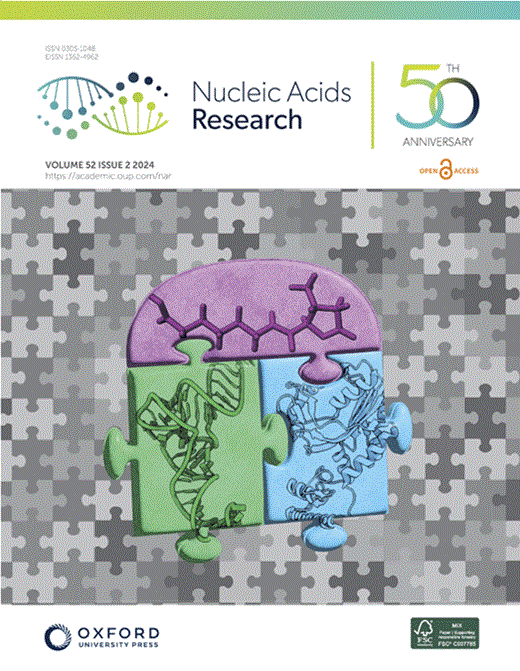Twisting tetraplex DNA: A strand dynamics regulating i-motif function in diverse molecular crowding environments
IF 13.1
2区 生物学
Q1 BIOCHEMISTRY & MOLECULAR BIOLOGY
引用次数: 0
Abstract
Intercalated motif (i-motif) tetraplex DNA plays a crucial role in gene expression and diseases. However, due to the limited number of i-motif binding proteins in human cells, the chemical mechanisms regulating i-motifs within cell remain currently unknown. Thus, molecular environment should have a main factor to control i-motif formation and functions in cells. Here, we systematically investigated the stability and functions of i-motif DNAs by using various polyethylene glycols (PEGs) and oligoethylene glycols (OEGs) that mimicked diverse cellular crowding environments. We found that the human telomere i-motif was significantly stabilized by PEGs and OEGs having six or more ethylene glycol units, whereas it was destabilized by those having less than six units. As these stabilization effects coincided with the drastic changes in hypochromicity by i-motif helixes, we quantitatively validated these effects through changes in solution properties and by assessing the twisting of the tetraplex structure using nuclear magnetic resonance (NMR) and molecular dynamics simulations. Furthermore, cosolute-induced twisting dynamics controlled by different cosolutes changed the activation energy barrier of replication by a twofold magnitude along the i-motif-forming DNAs. Our findings indicate that regulatory mechanisms underlying the biological roles of i-motifs across different cellular phases may exist by molecular environments.扭曲四体DNA:在不同分子拥挤环境中调节i-motif功能的链动力学
嵌入基序(i-motif)四联体DNA在基因表达和疾病中起着至关重要的作用。然而,由于人类细胞中i-motif结合蛋白的数量有限,细胞内调节i-motif的化学机制目前尚不清楚。因此,分子环境应该是控制细胞中i-motif形成和功能的主要因素。在这里,我们系统地研究了i-motif dna的稳定性和功能,通过使用各种聚乙二醇(peg)和低聚乙二醇(OEGs)来模拟不同的细胞拥挤环境。我们发现,具有6个或更多乙二醇单位的peg和OEGs显著地稳定了人类端粒i基序,而具有少于6个乙二醇单位的peg和OEGs则不稳定。由于这些稳定效应与i基序螺旋引起的低色性的剧烈变化相一致,我们通过溶液性质的变化以及使用核磁共振(NMR)和分子动力学模拟评估四联体结构的扭曲来定量验证这些效应。此外,由不同的co溶质控制的co溶质诱导的扭转动力学使形成i基序的dna复制的活化能势垒发生了两倍的变化。我们的研究结果表明,i-motif在不同细胞阶段的生物学作用可能存在分子环境的调节机制。
本文章由计算机程序翻译,如有差异,请以英文原文为准。
求助全文
约1分钟内获得全文
求助全文
来源期刊

Nucleic Acids Research
生物-生化与分子生物学
CiteScore
27.10
自引率
4.70%
发文量
1057
审稿时长
2 months
期刊介绍:
Nucleic Acids Research (NAR) is a scientific journal that publishes research on various aspects of nucleic acids and proteins involved in nucleic acid metabolism and interactions. It covers areas such as chemistry and synthetic biology, computational biology, gene regulation, chromatin and epigenetics, genome integrity, repair and replication, genomics, molecular biology, nucleic acid enzymes, RNA, and structural biology. The journal also includes a Survey and Summary section for brief reviews. Additionally, each year, the first issue is dedicated to biological databases, and an issue in July focuses on web-based software resources for the biological community. Nucleic Acids Research is indexed by several services including Abstracts on Hygiene and Communicable Diseases, Animal Breeding Abstracts, Agricultural Engineering Abstracts, Agbiotech News and Information, BIOSIS Previews, CAB Abstracts, and EMBASE.
 求助内容:
求助内容: 应助结果提醒方式:
应助结果提醒方式:


